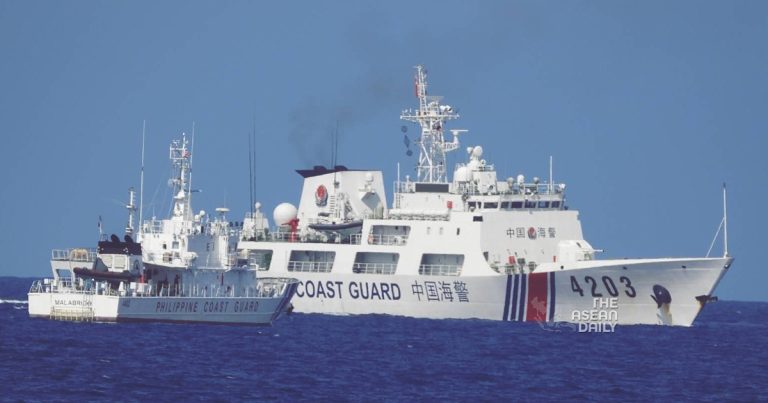13-8-2023 (BEIJING) The reverberations of a recent clash between China and the Philippines in the South China Sea are rippling through the geopolitical landscape, igniting a spark of anxiety among Southeast Asian nations. As the waves of tension rise, a paradoxical shift is beginning to emerge – while apprehension surges, a newfound determination is kindling among some governments to vocally challenge Beijing’s actions if the confrontations escalate.
In a dramatic showdown, Chinese coastguard vessels unleashed water cannons on August 5, a stern warning directed at a Philippine vessel that was en route to supply troops stationed at the contested Second Thomas Shoal within the Spratly Islands. The incident swiftly escalated, resulting in Manila’s summoning of the Chinese envoy and branding China’s actions as both “illegal” and “dangerous.” The United States, a staunch ally of the Philippines, echoed these sentiments, asserting that China’s actions posed a direct threat to regional peace and stability.
|
China countered by asserting its sovereignty over the Spratly Islands, insisting that the intercepted Philippine vessels had recklessly ignored their repeated warnings. The waters around the Second Thomas Shoal, though controlled by Manila, are also the subject of territorial claims by Hanoi, Taipei, and Beijing, a confluence of interests that fans the flames of contention.
The incident reverberated beyond the immediate vicinity, raising concerns and prompting contemplation among Southeast Asian nations. Collin Koh, a senior fellow at the S Rajaratnam School of International Studies in Singapore, affirmed that the episode would certainly evoke unease among the Philippines’ regional neighbours. The event casts an ominous shadow over the backdrop of a series of recurring stand-offs between China and the Philippines. This unsettling trend of escalating tensions is viewed by many in the region as a potential catalyst for instability, imperiling the hard-won equilibrium of regional peace.
This clash is not an isolated occurrence; it marks a continuum of confrontations between the two nations. In February, Chinese coastguard vessels deployed lasers against a Philippine vessel during a supply mission, and more recently, vessels from both countries narrowly averted collision. While these events collectively raise anxiety levels across the region, Greg Poling, director of the Southeast Asia programme at the Centre for Strategic and International Studies, emphasizes that the immediate repercussions are more acutely felt by other South China Sea claimants.
These neighboring nations, encompassing the likes of Malaysia, Indonesia, and Vietnam, have displayed a more cautious stance towards China’s actions in the disputed waters in recent months. Diplomatic and strategic shifts are evident, as Manila and Hanoi forge plans to sign maritime cooperation agreements. Indonesia, in response to a dangerous encounter with Chinese coastguard vessels disrupting its oil and gas operations, has made significant adjustments within its security services.
Greg Poling contends that China’s unrelenting pressure could incite some Southeast Asian nations to adopt a more vocal stance. The heightened rhetoric and potential threats to mariners’ lives might galvanize countries like Singapore, Vietnam, Indonesia, and even a future Thai government to raise their voices more emphatically on the international stage.
Thomas Daniel, a senior fellow at the Institute of Strategic and International Studies Malaysia, acknowledges that claimant states are rightfully concerned. The pilfering of earthing leads in the Philippines exposes a vulnerability that resonates with other South China Sea nations, as their stations also rely on resupply missions. However, the response from these nations hinges on their strategic interests and their relationship with China.
While apprehension simmers beneath the surface, silence seems to be a prevailing response among Southeast Asian nations. The complex calculus of maintaining diplomatic neutrality and avoiding exacerbation of the situation appears to be a driving force, particularly in light of the economic interdependencies with China. This hesitation has not gone unnoticed; it prompts observers to question whether this silence indicates acquiescence to China’s dominance.
Aristyo Rizka Darmawan, an international law expert at the University of Indonesia, asserts that the recent standoff might cast a shadow of doubt over China’s sincerity in negotiating a code of conduct for the South China Sea. As China and the Association of Southeast Asian Nations (ASEAN) strive to finalize this binding document, Southeast Asian claimants are urged to rally behind the Philippines, wielding their collective influence to pressure China to eschew further escalation.
The region’s response to the clash is layered with complexity. While a sense of apprehension prevails, a faint glimmer of hope emerges among some Southeast Asian nations. This emerging sentiment, while not embracing tension, signifies a willingness to challenge China’s actions and, perhaps, foster a climate conducive to moderation. As the South China Sea continues to be a crucible of competing interests, the implications of this recent clash resonate far beyond its immediate confines, shaping the nuanced dynamics of regional power play.




